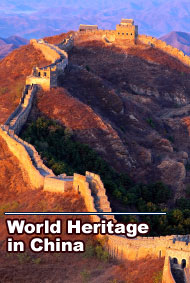
|
|
|
The Ancient City of Pingyao (Central Shanxi Province)
a. Brief Introduction This is the best-preserved historic townscape in the regions populated by the Han ethnic group. The Old Town of Pingyao lies in Pingyao County in central Shanxi Province. It was constructed during the reign of King Xuan of the Western Zhou Dynasty (C.827-782B.C.) and has been a county seat ever since the establishment of the prefecture-and-county system in ancient China. Today, Pingyao looks much the same as it did during the Ming (1368-1644) and Qing (1644-1911) dynasties. Pingyao is known mainly for three historical treasures: the ancient brick city wall, the Zhenguo Temple, and the Shuanglin Temple. The city wall of Pingyao was originally built using rammed earth, and was rebuilt with bricks in 1370 during the reign of Emperor Hong Wu of the Ming Dynasty. The wall extends for six km, and testifies to the profound influence of Confucianism in this region, as the 3,000 embrasures on the wall are said to represent the number of disciples of Confucius, and the 72 small watchtowers represent his 72 top disciples. In the later period of the Qing Dynasty, the Kuixing Pavilion was built on the southeast section of the wall, and became a symbol of the flourishing culture of the ancient city. Pingyao occupies an important place in the financial history of modern China. It was the location of the Shanxi Commerce and Rishengchang Piaohao, a kind of banking firm dealing mainly in the transfer of money. The now-defunct firm is considered to have been the predecessor of modern banks in China. During the Ming and Qing dynasties, along with the development of the economy and commerce, several large commercial firms in Shanxi Province opened branches outside the province, thus establishing a trans-regional business network. The circulation of commodities and the transfer of money gave rise to the piaohao. In 1824, the Rishengchang Piaohao, the first banking firm in China, was established on what had been the site of the Xiyucheng Pigment Shop on Xidajie Street. Three years later, Rishengchang opened branches in Shandong, Henan, Liaoning, and Jiangsu provinces. In the 1840s, it expanded its operations to Japan, Singapore, and Russia. Following the example of Rishengchang, more than 20 piaohaos opened one after another in Pingyao, turning the town into the financial center of China. |